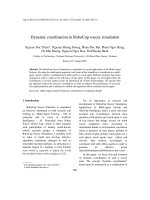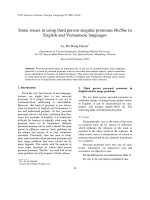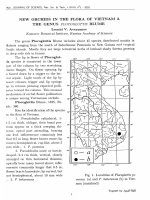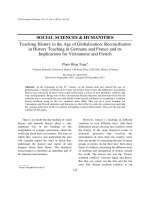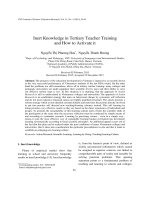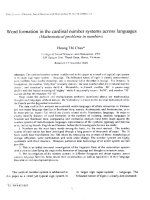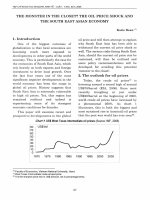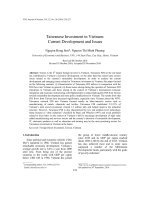DSpace at VNU: Dynamic coordination in RoboCup soccer simulation
Bạn đang xem bản rút gọn của tài liệu. Xem và tải ngay bản đầy đủ của tài liệu tại đây (1.56 MB, 12 trang )
Tạp chí Khoa học ĐHQGHN, Khoa học Tự nhiên và Công nghệ 23 (2007) 200-211
Dynamic coordination in RoboCup soccer simulation
Nguyen Duc Thien*, Nguyen Hoang Duong, Pham Duc Hai, Pham Ngoe Hung,
Do Mai Huong, Nguyen Ngoe Hoa, Du Phuong Hanh
College o f Technology, Vietnam National ưniversity, 144 Xuan Thuy, Hanoi, Vietnam
Received 15 August 2007
Abstract. The RoboCup Soccer Simulation is considered as a goođ application of the Multi-Agent
Systems. By using the multi-agent approach, each team in this simulation is considered as a multiagent system, which is coordinated each other and by a coach agent. Diíĩerent sữategies have been
proposed ÚI order to improve the eíĩiciency of this agent. In this paper, we investigate íirstly the
coordination in several modem teams by identiíying alỉ of theữ disadvantages. We present then
our approach related the dynamic coordination in order to improve the períònnance of our team.
The experimentation and evaluation to validate this approach will be concluded in this paper.
Keywords: Multi-Agent Systems; Dynamic coordination; Coordúiation Graph.
1. Introduction
RoboCup Soccer Simulator is considered
an eíĩective instrument in both research and
training on Multi-Agent Systems - MA ÚI
particular and in sector o f Artiíĩcial
Intelligence - AI. Proceeded from Robot
Soccer World Cup, which is held annually
with participation o f namely world-known
robotic research groups, a Champion o f
RoboCup Soccer Simulation is parallely held
in order to build and develop eíĩective
algorithm, considerate strategies as well as
reasonable leaming methods, etc directing to a
supreme targets o f « buiỉding a robot /ootbaỉl
team which is capacble to defeat the world
best/ootball (eams (with realplayers)» [1].
* Corresponđing author. Tel.: 84-4-7547615.
E-mail: thiennd@ vnu.edu.vn
For its importance to research and
development o f RoboCup Soccer Simulation,
applications o f M ulti-agent System and
Artiíicial Intelligence plays a more and more
essential role. Coordination between team
members, both players and coach agent, is own
o f key factors that brings success for robot
soccer simulation team. According to
iníòrmation thanks to environment experience
(such as positions of each player, position of
ball, context o f play ground, coach agent, etc.),
each player (each agent) must collect and
classiíy,
then
analyze, accordingly to
coordinate vvith other fellow-agents in order to
generate
an
eíĩective
action
(attack/defende/pass/dribble/shoot and score)
In this paper, we focus íìrst and íoremost
on dynamic coordination in such a soccer
team. The concept “dynamic coordination”
herein m ust be understood as a combination of
N .D . T h ie n e t al. / V N U ìo u m a l o f S c ừ n c e , N a tu r a l S c ừ n c e s a n d T e c h n o lo g y 2 3 (2 0 0 7 ) 20 0 -21 1
traditional coordination techniques in the
multi-agent system [2] and dynamic tackling
strategies which shall be applied subject to
cuưent status o f environment.
Remainding o f this paper is composed of
basic concepts o f coordination in multi-agent
system as shown in part 2. Following in-depth
introduction to the multi-agent system of
robocup soccer simulation in section 3.1, we
shall specify the way to access o f dynamic
coordination
in
section
3.2
and
experimentation results in section 4 as well.
And the íìnal section o f this paper is for
evaluation o f any resulted related.
2. Coordination in Multi-agent System
Coordination is one among three important
íactors 1 during reaction process between
agents in a Multi-agent System (MAS).
According to diíìnition by M. Wooldridge [1],
coordination between agents has close
relationship with inter-dependencies among
activities o f agents. There are many different
ways o f accesses in carTying out coordination
in a MAS, such as Coordination through
partial global planning, Coordinatỉon through
joint intentions, Coordination by mutual
modeling, Coordination by norms and social
laws, etc [1]. The typical method out o f those
listed above is namely based on Nashequilibria.
The essential point o f Nash-equilibria is
that in case of large number o f agents, it is
very sophisticated and takes time to calculate
and determine “balance” action for each agent
[3]. For that reason, subdivision o f acting
space of agents to be analyzed becomes
effective. Considering problem o f robot soccer
1 Three these factors arc : coopcration, coordination and
negotiation.
201
simulation, coordination betvveen agents has an
intimate relation with iníbrmation collected
from environment o f simulated robot. Hence,
coordination graph is proposed in order to
intensiíy
possibility
betwecn
mutual
coordination among agents and with coach
agent. In this section, following 2.1 for
explanation on this method, we shall also
mention another method based max-plus
algorithm in section 2.2.
2.1. Coordination
Elimination
graph
and
Variable
In a multi-agent system, each agent shall
take indibidual action, o f which results,
however, are under iníluence o f behavior of
other agents. In such a multi-agent system with
mutual coorperation between agents [4] (a
simulated robot soccer team for instance), set
A includes individual behaviors A| of every
agents aỊ and creates a joint action satisíactory
with optimization conditions o f global p a y-o ff
/unction.
During process o f implemention, each
agent must choose a reasonable individual
action to optimize joint-action o f the whole
system (for instance, based on Nashequilibria). However, number o f joint-actions
increases in accordance with exponential
function and number o f agents, and this causes
the determination o f balance statuses noníeasible in case o f large number o f agents.
For pupose o f solutions to this problem,
coordination graph - CG and Variable
Elimination - VE are applied by Guestrin et al.
[5]
who consequently brought solutions to
sophistication
degree
on
process
for
D eíìnition : Coordination graph (CG) G = (V,
E) is a directional graph, o f which each dot o f
V is an agent and a certain side o f E is
dependent to coorperation o f two end-agents [6].
202
N .D . T h iert e t al. Ị V N U Ị o u m a ỉ o Ị S à e n c e , N a tu r a l S cienceũ a n d T e c h n o lo g y 2 3 (2 0 0 7 ) 2 0 0 -2 1 1
Naturally, at a certain point o f time, only
agents connected with others and shown on
CG should be coordinated with those agents.
For example, see Fig.l below which
demonstrates a CG with 4 agents. IN this
example, AI must coordinate with both A2
and A3 while A2 must coordinate with both
A l, and A3 coordinates with A4 and A l,
whereas A4 coordinates with A3.
■
B3; Eliminate ai out o f Coordination
Graph and repeat BI till there is only one agent
left in Coordination Graph. This agent shall
select optimal action from sets of actions
available for its.
•
Phase 2: carried out in resverse sequence
of agents according to phase 1. Each agent
determines its optimal action based on actions
determined by its neighbor agents before.
For further illusừation o f períormance
process o f variable elimination, let’s consider
an example shown in Fig. 1 with four agents
above. In this example, pay-off function of
every joint-action of four agents shall be
determined with functioii
U (a)= fl(a1>a 2) + f2(aI, a 3) + f j( a ,t a4) ( l )
(here, we consider aj as action o f agent Aj and
a as joint-action o f all agents)
Fig. 1. Coordination graph of four agents.
Major idea o f this access depends on the
global pay-off function U(A) to be
disintegrated into sum o f global pay-off
function which relates to some agents only.
For purpose o f determining optimal action for
every agent, Variable Elimination is used by
Guestrin in similar way with variable
elimination in Bayesian network [1,2].
According to [6], this algorithm operates in
two phases: eliminating variables and
determining optimal actions as folows:
• Phase 1: Variable Elimination
■ B l: Select agent, ai; and determine payoff functions U j from all neighbor agents of a j
(neighbor agents - NAj, is obviously
determined through Coordination Graph).
■ B2: optimize decision o f aj depending on
action combinations available in set NA( and
transmit results to its neighbor agent aj
(belonging to NAj).
Firstly, let’s eliminate agent Aj. This agent
depends on two functions f| and f2 and
maximum value o f Ư(A) shall be determined
through formula:
m a x U ( a ) = m ax Ị f , ( a , , a 4) + m a x [ f l( ú 1, a ! ) + f} (a ,.a,)]Ị ( 2 )
From A |, we have a new pay-off íunction
f4(a2, a , ) = max { f ,( a ,,a 2) + f2( a ,,a ,) } in
accordance with ơ\. This is function that brings
relevant value with its best-response in
combination o f any action available of a 2 and
a3 (signalized as B|(ữ2, « 3))- At that time,
function /4 is completely dependent from rt)
and a I is eliminated from graph.
Apply
above-mentioned
process
to
eliminate a2, now there only left with í,
depending on action of agent a 2 and replacing
by íunction f5( a 3) = max { f4(a2, a 3) } in
accordance with a2. Next, we eliminate a 3 by
replacing
íunction /3
and /5
with
function f6( a 4) . Hence, max U(a) in
accordance with a = f6( a4) according to a4.
At this time, A4 shall be the optimal action of
a *4itself.
N .D . T h ie n e t al. / V N U Ị o u m a l o f Science, N a tu r a l S c ứ n c e s a n d T e c h n o lo g y 23 (2 0 0 7 ) 200-211
After selecting action o f A4, optimal
actions o f remaining agents shall be carried out
in reverse sequence. In this example, action of
A 3 shall be determined through the bestresponse function related to a 4: a *3 = B3(a 4).
Similarly, a *2 = B 2(a*j) and a*i = B,(a*2, a*3).
203
considered as optimal global pay-off function
between two agents i and j in a side of CG
[8,9]. This allows an approach an optimal
action of each agent after every two certain
repeat [6].
In any even o f an agent having more than
one best-response action, it shall randomly
select one o f them. This selection shall not
affect joint-action because that selection shall
inform its neighbor agents.
Effect o f Variable Elimination algorithm
does not depend on order o f elimination, and
always brings optimal joint-action o f agents.
Yet, períormance time o f this algorithm
depenđs on the sequence o f variable
elimination and sophistication degree of
exponential function for width o f CG.
Furthermore, this shall only take effect only
when phase 2 completely íĩnishes and that is
why it is unreasonable for any MAS to deal
with real-time, taking robot soccer simulation
as an example (each player must determine its
next action after every lOOms). Solutions to
these weak points o f CG and VE shall be
mentioned in next part, based on Max-plus
algorithm which was proposed by J. Kok and
N. Vlassis in 2005 [7].
2.2. Max-plus Algorithm
Another very effective algorithm in
improving the coordination between agents has
been studied and successfully applied by UvA
Trileam for TriLeam 2005 Multi-agent
System. This algorithm namely depends on
CG, yet, despite o f VE, [6] is used with maxplus algorithm thanks to which the main idea is
to determine maximum a posteriori in nondirected graph.
Above-proposed method relies on sending
again and again messages |iij(aj), which is
Fig. 2. Illustration of Max-Plus Algorithm.
Consider non-directed graph G - <V,E> o f
which, |V| is number of points, |E| is number of
sides of graph. The global pay-off function
Ư(A) is calculateđ as follows:
U(a) = I f ,( a ,) - I
i«v
(i.iXE
f,((«,.*,)
O f which,
demonstrates costs for action
ai of Aj and fjj as action mapping pay-off
íiinction (aj,aj) of two agents i , j e E near to a
real number fịj(ai>aj), aiming at fmding the best
joint-action a* with (3) in maximum.
Each agent i is sending repetitively
message |jjj to its neighbor points j € r(i), of
which |ijj maps action aj o f agent j to a real
number following íormula:
O f which,
r(i)\j
is all neighbor points of
agent i except agent j, and Cjj is normalized
vector. This message can be understood as
appropriate value of maximum pay-off value
204
N .D . T h ie n e t al.
/ VNU Ị o u m a l o f Sríen ce, N a tu r a ỉ Scien ces a n d
to which agent i reaches with any actions of
agent j,
and is calculated as grand sum
(through actions o f agent i) o f pay-off
íimctions f j , fjj and all messages sent to agent i
except those sent from j. Messages are
exchanged until they bring together again as
gi(ai) = fi(ai)+ ]T M-ijCaì) • At that time, every
T e c h n o lo g y 23 (2 0 0 7 ) 2 0 0 -2 1 1
In the most recent time, at the competition
held in May 2006 in Germany, the
championship vvas won by WrightEagle of
China University o f Science and Technology,
and followed by Brainstormers o f Germany
Osnabrueck University and Ri-one o f Japan
Ritsumeikan University3.
j*r
follows: a’ = argm ax,
. If only One
action reaches maximum for all agent i,
optimal joint-action a*= arg max,(U(a)) is the
unique with element a*= ( a*).
3. Multi-agent System for RoboCup Soccer
Simulation
3.1. RCSS Competiton
RCSS (RoboCup Soccer Simulation) is a
competition
among
RoboCup
Soccer
Simulation teams, o f which each must
establish a multi-agent system with every o f its
agents to be considered as a Client, and
períòrmed in the same environment against a
competitor [10]. The whole evnvironment of
MAS is managed by a server (RoboCup Soccer
Server - RCSS), which Controls environment
and is a element managing competition rules as
well [6]. Correspondingly, RCSS has been
coded and required compliance o f all soccer
teams. There is no limit in the way teams are
built up, the only requirement is that
instrument used to develop a team must be
supported by a client-server through ƯDP/IP
Socket. Each Client is a process independently
linked to server with a separate portal. Rules
applied for this competition is govemed by
FIRA2 with 11 players in maximum.
For íuither iníormation, visit />
3.2. Dynamic coordination o f robot simulation
agents
RoboCup Soccer Server provides a
dynamic and discrete environment, which
modelizes many real environmental factors
such as movement noise, interference sensor,
limited physical abilities and restrainted
conmmuniations.
However, in RoboCup Soccer Server, there
is only one agent, at every point of time,
permissible to communicate with Server.
Thence, agents must observe and store the
environmenta! status inside. IN the event o f no
action coordination, a player moves to a
position where he observes the ball’s speed
change. Before the ball’s speed changes, that
player has no notion he will practically receive
the ball and thus does not coordinate with the
passing-ball-player.
In order to íĩnish coordination, all agents
firstly are assigned with particular role in
accordance with current context. Then, these
roles shall be coordinated by applying Variable
Elimination algorithm with value principles
defined so as to make the best use o f jointaction and environment variables. Below is
detailed description how to use coordination
graph to coorđinate the ball-passer and ballreceiver, the íirst ball-receiver and second ballreceiver, i.e. who receives ball from the íìrst
ball-receiver.
3 For ủirther details, visit Ranking.html
N .D . T h ie n et al. / V N U Ị o u m a ỉ o ỊS c ie n c e , N a tu r a l S á e n c e s a n d T e c h n o lo g y 2 3 (2 0 0 7 ) 200-271
205
Goalkeeper, Central defender, svveeper,
wing deĩender, Central m idfielder, wing
midíielder, wing attacker và Central attacker
At that time, all agents linked together
must coordinate their actions. E.g. an agent can
choose one o f following actions:
First o f all, a Role Assignment Function
shall be applied to assign roles for players: the
defenđer, the ball-passer and the ball-receiver,
etc.
depending
on
ìníromation
from
environment. This role assignment can be
calculated directly from infonnation on current
context. For instances, a player standing
nearest to the ball can be assigned as a
đeíender when it is impossible for him to kick
the ball, and as a ball-passer when possible for
him to kick it. All roles assigned to agents are
aưanged subject to position o f ball. Any
players, who have not been assigned with any
role, are in passive State. This role assignment
helps build up structure o f Coordination Graph
on which roles o f saving, passing or receiving
ball are linked together [11]. And this role
assignment can be changed in coníbrmity with
the change o f ambient environment.
- PassTo (i, dừ •): pass the ball to a certain
position with a íixed distance from agent i in
direction of dir, D={center, n, nw, w, sw, s, se,
e, ne}
- MoveTo(dir): move in direction of d ừ
- Dribble(dir): bribble the ball in direction
o f dir
- Score: attempt to drive the ball into the
contender’s goal
- ClearBall: strongly kick the ball among
the contender’s players towards the contenđer.
- MoveToStratPos: move to strategic
position o f agent (according to situation of
home team and cuưent position o f ball)
Existing rules can be directly modified or
rubbed out, creating possibility to change
strategies of team when playing against many
different kinds of contenders.
Fig. 3. Coordination graph based on roles of agents.
206
N .D . T h ie n e t a i í V N U Ị o u m a ỉ o f Science, N a tu r a l S cien c es a n d T e c h n o lo g y 23 (2 0 0 7 ) 20 0 -2 1 1
Those rules contain many ties of the
environment that are described by State
variable. In fig. 3, we will simplify
coordination graph based on roles o f agents if
there are more environment variables which
are suitable with following value rules
(Supposed that there are only environment
variables!isPassBlocked(l,2,s)and!isPassBlock
ed(2,3,nw) with value True):
A l: (p 1 P“ 5fr; ai = passTo(2,s) Aa =moveTo(s): 50)
(p2 ixastT; ai = dribble(n): 30)
(p3
aiearBall: 10)
A2:
(p7
02 = moveToStratPos : 10)
A3:
(p6 "cntrr; ai = passTo(2, dừ) A dĩ =
moveTo(dir) A03 = movéTo(nw): 30)
(p7 ircrrôơ- 43 _ moveToStratPos : 10)
By applying exception algorithm, each
agent will be eliminated from the graph by
value maximums that retum locality (Pay-Off).
In case agent A 1 is eliminated íĩrst, it will
collect all value rules that contain ữ/ and report
its strategies to patemal agents:
(pl
al = moveTo(s) A cữ -m oveTo(nw ): 80)
(pl P"5"; a2 = moveTo(s) A «3 = moveTo(mv): 50)
(p3 P"5"; a2 = ImoveTo(s): 30)
After agents A2 and A3 have íìxed their
strategies, agent G2 will implement the action
passTo(2,s), agent G2 will implement the
action moveTo(s) to take ball, and agent G3
will implement the action moveTo(nw) to
receive possible ball passed from agent G2. In
case of unexpected possibilities such as the
íirst ball passed from GI to G2 fails,
coordination graph will automatically
updated in coníormation with new event.
Sừategies
coordination
of
proposed
be
dynamic
UvA Trilearn Team is the championship
one o f simulation competition in 2003 and the
source code has been proclaimed to help
people for leaming and research. In UvA
Trileam,
8 real players are deíĩned:
goalkeeper, Central defender, sweeper, wing
deíender, Central midfielder, wing midíielder,
wing attacker và Central attacker. Moreover,
the source code of UvA Trilearn team is
clearly and understandably written, and it has
been used as the development basis o f many
intemational teams such as FC Portugal with
championship in 2004. This is the main reason
that group o f authors select it as the
development basis of the team.
Based on Trileam 2003, we have proposed
some strategies related to action o f each
agenưplayer. These strategies are to advance
the eííect of dynamic coordination between
agents in team. From that, following actions
can be earliest and most effectively identifíed.
a. Ball handlỉng strategy
Ball handling strategy of each player in
Trileam 2003 is simply set up. Moreover, ứiis
strategy has some weak points as follow: If
kickable, player will kick it (towards an
accidentally kicking direction). Othenvise,
considering whether that player is possible to
approach the ball at the quickest time. If
possible, let him approach the ball. Or else, let
him mo ve back to strategic position.
Our strategy aims at correcting abovementioned weak points. Specifically, at the
start of the match, player’s formation will be
arranged and player number 9 kicks o ff the
ball at maximum speed (but in accidental
direction) towards the goal. In the match, if
players does not see the ball, it will be
searched with meíhod searchBall. In case the
ball (unđer possession) s kickable, it will be
kicked towards the goal. In case o f no ball
possessed, players will measure whether they
N .D . T h ie n e t a i / V N U l o u m a l o f Scien ce, N a tu r a l S c ừ n c e s a n d T e c h n o lo g y 2 3 (2 0 0 7 ) 2 0 0 -2 1 1
are the quickest ones to approach the ball. If
possible to approach the ball, do it. Othenvise,
move the player back to strategic position,
which is determined by current position o f the
player, role o f the player (midfielder, deíender,
etc) and ball position.
b. Ball searching strategy
Uníòrtunately, Trileam 2003 is just only
simple ways o f ball scarching. Specifically in
íunction searchBall, players’ visual sector is
default with half-space before their eyes. This
provides a better observation to players.
However, this is not substantially true to
players. Each player has his own characteristic
so-called viewAngle. I.e. each player only sees
ball within cone domain under viewAngle. If
not seeing the ball, they will move towards ball
direction that they last see it. Following
searchBall method, players will move in
slanting direction o f 60° from previous
position. This is not totally optimal because in
many cases players can see the ball with only a
little change of viewAngle\ w hat’s more, it may
be impossible for them to see the ball even
viewAngle has been dirccted to 60° angle.
Our improvements are to provide
additional
characteristics
of
players’
viewAngle: visual sector o f each player is cone
angle called viewAngle. If the ball is out of
cone angle, players can not see it. With new
method, in order to see the ball, players will
observe in diíĩerent directions. Players will
observe in a direction slanteđ with a small
angle from the previous One. This observation
will be done many times until players see the
ball. Like this, players will observe in diíĩerent
directions until they see it.
c. Strategy o f ball possession
Dribble method in Trileam 2003 requires
207
parameter called dribble direction, which is
just calculated but unrealized yet. This means
players can not dribble the ball in case rivals
prevent it.
Accordingly, we suggest a sừategy of
possessing ball as follow: player will observe
to speciíy rivals in front o f him and the ball;
then the ball possessor shall dribble the ball in
a direction diíĩerent from the rival’s or dribble
it fast across the rival. Such advanced dribble
method helps deíine the opposite player.
Therfore, dribble direction can be detemiined
whether diíĩerent from direction towards the
opposite player, or the same the dừection
towards the opposite player but with
DRIBBLE_FAST. Improved dribble method
only weighs dribble direction. It recalls íormer
function by providing parameter o f this
calculated dribble direction.
d. Strategy o fb a ll passing
In Trileam 2003, when the match starts,
íormation o f players will be arranged, the
player number 9 will kick o ff the ball at
maximum speed (but in accidental direction
towards the goal). During the match: in case
player does not see the ball, it will be searched
using method searchBall. When the ball (under
possession) is kickable, it will be kicked in an
accidental direction towards ứie goal. In case
of no ball, player will measure his posibility to
be íastest in approaching the ball. When the
ball is approachable, do it. Othenvise, move
the player back to strategic position, which is
determined in accordance with íormation of
433, 442, etc, current position o f player and
role of players (midfielder, defender,etc), ball
position. Obviously, this is not optimal at all.
Passing strategy suggested is displayed as
follow: If the match starts, formation of
players will be done, the player number 9 will
208
N .D . T h ie n e t al. / VNU Ị o u m a l o f S cience, N a tu r a ỉ S cien ces a n d T e c h n o lo g y 2 3 (2 0 0 7 ) 2 0 0 -2 1 1
pass the ball to player number 7 who, in tum,
will handle the ball (as his position is more
íavorable than player 9). During the match: In
case player does not see the ball, it will be
seeked for (with method RearchBallApp
instead o f method searchBalỉ). In case players
are tackling a free kick (the ball must be
kicked or passed), the ball will be passed to the
player in favourable position (with method
passBall). If the ball is searched, it will be
passed. Othenvise, the ball will be kicked
towards the goal with maximum strength. In
case the ball (under possession) can be kicked
through a reasonably small distance from the
player to the goal (smaller than 90% * (ability
of the ĩurthest shoot by this time is based on
physical force o f players)), the ball will be shot
towards the goal. Defender, if seeing no rival
player within a radius of 5 measurement units,
decides to drìbble ball. If íacing against a rival,
he will choose to clear the ball (using method
clearBaỉI). Non-defender vvithout any rival
player in front shall dribble the ball towards
the goal. In other cases, the ball will be passed
(to any fellow favorable to receive the ball) or
sừongly kick the ball ahead (if no player íound
able to receive the ball). In case o f no ball:
continue to approach the ball, if possible, or
move to the strategic position.
In
Trileam
2003,
the
metfrod
getStrategicPosition is applied in working out
strategic position o f players by taking home
position o f each player present in íòrmation in
combination with position o f the ball that uses
gravitational value. Strategic coordinate of
players
is
calculated
following
formula:
Current value of players + current value o f the
ball * gravitational value. If this co-ordinate is
smaller than the minimum one or bigger than
maximum one, it will be set to that minimum
or maximum value.
Our
improvements
are
proposed
as
follows: If player is right behind the ball, he
then tums back to strategic position or ball
position. Or else, strategic position will be
calculated as follows: Position of players on
strategic coordinate is calculated following
formula: current value o f players + current
value o f the ball * gravitational value. Next,
check whether this value is out of touch-line
(?) and assign it back to position at line if it is
actually out o f the touch-line. Concurrently,
check if co-ordinate o f player is behind the
ball, and assign his coordinate at the same One
o f ball (in order to possess the ball).
e. Formation
4. Experimental rcsult
The main formation iníbrmation is the way
to arrange and organize formation, including:
Iníbrmation
about
different
íormation
methods’ such as 4.13, 442,... (stored in the
fĩle Fomaíions.conj). The way o f arranging
players into íbrmation (i.e. position coordinate of players). The main procession in
this module is method getStrategicPosition
because it will determine strategic position to
which player with no ball must move.
Based on proposed dynamic coordination
strategies,
we
have
experimented by
developing team called TrileamA from source
code o f UvA Trileam 2003. Aíter setting up
TrileamA, we made an experiment by
organizing matches between team TrileamA
and former UvA Trileam 2003 and another
match with team Brainstomer - the Champion
in 2005.
N .D . T h ie n e t a i / V N U Ị o u m a l o f Scien ce, N a tu r a l S cien c es a n d T e c h n o lo g y 2 3 (2 0 0 7 ) 2 0 0 -2 1 1
209
l ^ r ‘ Ị«rn:_Q_________
Fig. 4, Details of match between TrileanA (right) and Trileam 2003 (left).
With
experimental
confíguration
of
RAM 1GB, CPU 3.0 GHz system operating
with a V irtual machine Linux, results of
matches between TrileamA and two other
teams are clear evidence for advantages of
TrileamA with advanced sừategies, speciíìcally:
- Three matches between TrileamA and
UvA Trileam 2003, TrileamA won completely
with scores : 2-0, 3-1 and 3-0.
- Matches behveen TrileamA and Brainstomer
2005, TrileamA won 3 out o f 4 matches with
results 0-1, 1-0, 2-0 and 1-0 respectively.
Fig.5. Details o f the match between TrileanA (left) and Brainstormer (right).
210
N .D . T h ie n e t a i / V N U lo u m a ỉ o f Scien ce, N a tu r a ỉ S cien c es a n d T e c h n o lo g y 2 3 (2 0 0 7 ) 2 0 0 -2 1 1
5. Conclusion
This paper íocuses mainly on dynamic
coordination problem in Multi-Agent System.
From 2 approaching methods with application
o f coordination graph and max-plus algorithm,
we have proposed improvements o f dynamic
coordination through connection with 5
strategies for particular context. Experimental
results implemented with The RoboCup Soccer
Simulation RCSS
and open
source code
software UvA Trileam 2003 have confirmed
effects o f our improvements. This is the basis
for which group o f authors intend to enhance
ủirther effíciency o f the whole team in order to
participate in matches o f the Robot Cup Soccer
Simulation 2008.
Acknowledgements
This paper is partially funded from theme
coded 203006 under the program Basic
Reseach on Natural Science and partly from
theme coded QC.06.03, Hanoi National
ưnivesity.
EcỊuilibriums, In Proceedings of AAAI-2005
W orkshop
on
Multiagent
Leaming.
Pittsburgh, USA, July 10, 2005.
[4] p. Stone, M. Veloso, Muỉtiagent System: A
Survey from a Machine Leam ing Perspective,
Ferbuary, 1997.
[5] c .
Guestrin, s. Venkataraman, D. Kollcr,
Context-specific muỉtiagent coordination and
planning with/actored MDPs. In: Pr006Fc. 8 th
Nation. Conf. on Artiĩicial Intclligence,
Edmonton, Canada (2002)
[6 ] José M. Vidal, Learning in Muỉtiagent Systems:
An Introduction from Q Game-Theoretic
Perspective. In Adaptive Agents: LNAỊ 2636 ,
Eduardo Alonso editor, Springer Verlag, 2003,
p. 202-215.
[7] J. Laumonier, B. Chaib-draa, Partial Local
FriendQ Aiultiagent Leaming: Application to
Team Automobile Coordination Problem. In
Proceeđings of the 19th Canadian
Coníerence on Artificial Intelligence
(AI'2006), Quebec, Canada, June 7-9, 2006
[8 ] J.R. Kok, N. Vlassis, ưsing the max-pỉus
algorithm fo r multiagent decision making in
coordination graphs. In: RoboCup 2005: Robot
SoccerWorld Cup IX, Osaka, Japan (2005)
[9] M. Wainwright, T. Jaakkola, A. NVillsky, Trce
coìisistency and bounds on the performance o f
the
max-product
aỉgorithm
and
its
generaỉừations. Statistics and Computing 14
(2004) p. 143-166.
[10] K.I. Tsianos, Algorithms
Reíerences
[1] Objective o f RoboCup,
/overview/2 2.html
[2] Michael Wooldridge, An Introduction to Multi
Agent Systems, John Wiley, Sons, 2002,
[3] J. Laumonier, B. Chaib-draa. M ultm gent QLeaming: Preliminary Study on Dominance
betĩveen
the
Nash
and
Stackelberg
coordination
applications ,
of
multiagent
fo r
optimaỉ
systems and
Diploma
thesis,
National
Technical ưniversity of Athens, Grecce, June
2005.
[11] J.R. Kok, M.T.J. Spaan, N. Vlassis, Non communicative multi-robot coordination in
dynamic
environments.
Robotics
and
Autonomous Systems 50 (2005) 99.
N .D . T h ie n e t a i / VNƯ Ị o u m a l o f S c ie n c e , N a tu r a l S c ie n c e s a n d T e c h n o lo g y 2 3 (2 0 0 7 ) 2 0 0 -2 1 1
211
Phối hợp động trong hệ đa tác tử mô phỏng robot đá bóng
Nguyễn Đức Thiện, Nguyễn Hoàng Dương, Phạm Đức Hải, Phạm Ngọc Hưng,
Đỗ Mai Hương, Nguyễn Ngọc Hoá, Dư Phương Hạnh
Trường Đại học Công nghệ, Đại học Quốc gia Hà Nội, 144 Xuân Thủy, Hà Nội, Việt Nam
Mô phỏng robot đá bỏng (The RoboCup Soccer Simulation- RCSS) được xem là một ứng dụng
hữu ích trong việc nghiên cứu các hệ đa tác tử (Multi-Agent Systems - MAS). Với cách tiếp cận đa tác
tử, mỗi đội bóng được mô phỏng như một MAS, trong đỏ có sự phối hợp giữa các cầu thủ cũng như
với huấn luyện viên của đội -tác tử giữ vai trò điều phối cả đội. Các chiến thuật khác nhau nhàm cải
thiện hiệu quả vai trò của các agent. Bài báo này chú trọng đến quá trình phối hợp động trong một đội
bóng mà trong đó quá trình phối hợp giữa các tác tử sẽ được thực hiện thông qua các chiến thuật được
xác định theo tùng ngữ cảnh thực tế. Kết quả thực nghiệm thu được cho phép đánh giá khả năng áp
dụng tổt của cách tiếp cận phối hợp động đề xuất trong mô phỏng robot đá bóng.
Từ khóa: Hệ đa tác tử, phổi hợp động, đồ thị phối hợp.
